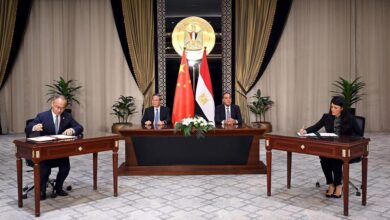
Since the Peloponnesian War that broke out in Greece in the 5th century BCE, theorists of international interactions have highlighted the relative positioning of the dominant power over other factors in the international order.
The importance of this war comes from the fact that it was one of the first documented historical accounts — by the Greek historian Thucydides — of a military clash between two powers.
One of these powers was a dominant force represented by the powerful and dominating Sparta and the other was a rising power represented by the ambitious and wise Athena.
Sparta saw dangers that might arise due to the assumption that Athena would compete with it for its share in the region, and this fear drove it to directly clash with Athena.
As fear is an innate feature of the human psyche, some experts see it — based on much historical evidence — as an inevitable drive for the outbreak of war between the rising power and the dominant power in any international order.
This explains why many analyses and observations tend to predict an inevitable war between the United States and China, because of the threat China poses to the geostrategic weight of American influence.
However, the high cost of large-scale destruction resulting from any war between two nuclear powers makes the decision to launch a nuclear war an irrational act, as both sides are capable of causing mutually assured destruction.
And because the American central mind should be serious in neutralizing the Chinese economic threat before it turns into an explicit military threat, this supports the hypothesis that deep-state circles in the United States have decided to exert pressure on multiple levels to limit the expansion of the Chinese dragon all over the world.
Perhaps the “Tariff War” initiated by President Donald Trump between American and Chinese exports is one of those means of increasing pressure since he took office.
On the other hand, the tools of fifth and sixth generation warfare are always present at the table of international tensions. Observers have often linked a mysterious event with such tools, aiming at assuming narratives of the possible political characterization of what is going on.
Of course, the outbreak of the novel coronavirus, which started in China, played a role in giving logical and — to some extent — causal reasoning to the proposition that this virus was synthesized in a laboratory by a certain actor whose goal is to weaken China without firing a single bullet, thus destroying its economic power in the short and medium term.
However, China’s success to date in responding to this epidemic on the one hand, and the emergence of the novel coronavirus in Western European cities and in more economically significant US cities such as California and New York on the other, supports the hypothesis that China has been able to absorb the first shock and direct the threat to other geographical spots.
Or perhaps the virus synthesizers made some miscalculations, and they never expected that it could reach their economic interests as well!
The accusation that China launched this virus is still a hypothesis without any compelling, or even supporting, evidence — especially since the hypothesis of being synthesized in a laboratory is still weak, refuted by many certain facts that it is of natural origin.
Until the facts unfold and the cloud of the “post-corona world” clears, China will still have many strengths that the United States views as a direct threat, the most important of which are:
China’s Military and Economic Growth
Until 2018, Chinese military spending was approximately $250 billion, with an increase of 190 percent compared to the 2008 military budget of $86.3 billion.
This spending was accompanied by China showing behavior that can be described as aggressive in relation to some situations, such as creating artificial military islands in the South China Sea and its claim to sovereign rights in this vital part of the world based on its ownership of the islands.
Then, in August 2017, China opened its first military base outside its borders in Djibouti, one of the countries in the Horn of Africa, overseeing the Gulf of Aden, to secure shipping lines for its vessels.
It has also been noted in recent years that China has adopted open positions in conflicts in more than one spot, such as its vote with Russia in the Security Council more than once, which means giving up its political neutrality that it usually follows in order to devote itself to its economic expansion in the international order.
Therefore, the policy of peaceful global rise, formulated by the Chinese political advisor, Zheng Bijian, may not be fit to explain the behavior of the current foreign policy, which does not confine its tools to soft power only for global repositioning any more.
The Growing Nuclear Power of China
Contrary to popular belief, China is not only developing its economy, but is working to develop its arsenal of nuclear weapons as well — especially tactical nuclear weapons.
American news website The Hill reported that according to the China Academy of Engineering Physics China conducted around 200 tests of short-range tactical nuclear weapons in the South China Sea in between September 2014 and December 2017, with an average of five tests per month.
The United States, meanwhile, conducts such tests once a month, according to data from the National Laboratory in California.
In contrast, in January 2018, the Pentagon published a new American nuclear doctrine that provides for low-yield nuclear weapons — which have a destructive effect, but on a limited scale — to deter its adversaries, the foremost being China and Russia.
In order to deter its adversaries the United States withdrew from the Intermediate‑Range Nuclear Forces Treaty, signed in December 1987 between the United States and Russia.
This was the only bilateral nuclear agreement of its kind, under which both sides agreed not to manufacture, test or deploy any ballistic, winged or medium-range missiles, and to destroy all missile systems with an average range of (500-5500) km.
The termination of this treaty in August 2019 also threatens the future of another agreement: the “START III” treaty signed in April 2010 between the United States and Russia, which expires in 2021.
This treaty is not expected to be extended unless Washington meets its nuclear security requirements — requirements that are not related to the Russians, but rather to the new militarily emerging power, China, which the United States wants to “drag” to sign treaties that enable it to control Chinese nuclear weapons quantitatively and qualitatively.
In the same month that the iIntermediate‑Range Nuclear Forces Treaty expired, President Donald Trump revealed his desire to include China in a new treaty with Russia. The Economist reported on an analysis of a former CIA agent, Christopher Johnson, linking withdrawal from the treaty to the tensions over the South China Sea.
China’s continued development of its medium-range tactical arsenals there makes it dangerous for the United States to adhere to a treaty that prevents it from developing similar capabilities. Johnson indicated that the early days can determine the fate of any war in the future, and that having military capabilities that enable the United States to reach the heart of Chinese territory is of great importance to the American military in any confrontation with the Chinese army.
If the United States does not have the ability to strike anti-ship missile bases located within Chinese territory, then its military capabilities in the region will be limited to its bases in Japan, and sending its warships to the waters near the coast of China would be a dangerous risk.
The Belt and Road Initiative
As part of China’s desire to harness economic globalization to serve its vital interests, Chinese President Xi Jinping announced in September 2013 the “Belt and Road” initiative aimed at establishing a land and sea network for goods and services from China.
According to expert estimates, this project is capable of shifting from the purely economic dimensions that China announced to more profound dimensions related to military positioning.
A detailed assessment published by the US Department of Defense in December 2018 warned that the Belt and Road Initiative may carry military dimensions if China manages to have a military presence along trade lines to secure its navigational capabilities and economic interests.
With the start of the coronavirus crisis in the West, China rushed to exploit the crisis diplomatically in a pragmatic way. It aimed to polish its image in front of the world, while also insisting on denying some health experts assumption that the source of the novel virus was the consumption of wild animals and bats in a traditional Chinese market!
After China was able to absorb the first shock and contain the most dangerous wave of the virus, it was quick to extend a helping hand to many European countries, such as Italy. Not only did Beijing supply Italy with medical equipment at a time when supplies were scarce, but it also sent health personnel with experience in dealing with the pandemic at ground zero in Wuhan.
It considered this initiative a part of constructing what the Chinese President described as a “Health Silk Road” in a phone call with Italian Prime Minister Giuseppe Conte when the first Chinese aid arrived in Italy. Rome was the first capital in the Group of Seven that joined the “Belt and Road” initiative in March 2019, which sparked American and European condemnation.
All these facts and others are important indications of the exacerbation of Chinese-American tensions, which may be a catalyst for some entities in America to develop the novel coronavirus as part of its hybrid warfare against China that started with tariffs.
On the other hand, it should not be forgotten that the nature of the spread of the virus may indicate that it was not synthesized in a lab — despite its strange composition, and despite a statement by the spokesman for the American College of Allergy, Asthma and Immunology, professor Talal Nsouli, who expressed on Al Arabiya his surprise at the composition of the virus on April 8, 2020.
He said that every RNA piece of the virus is designed to destroy a certain organ, wondered whether it was natural or not, but left identifying its source to politicians.
Until that happens, humanity will have to hold its breath, since finding compelling evidence regarding the involvement of a laboratory in artificially synthesizing the coronavirus will lead to a direct war after the hybrid rounds of warfare that we have witnessed.
___
Image: (AFP / SAUL LOEB)




